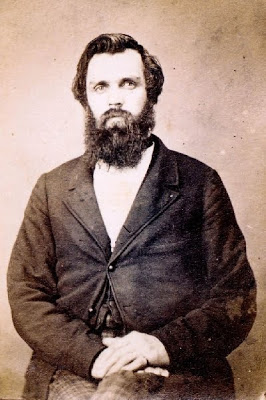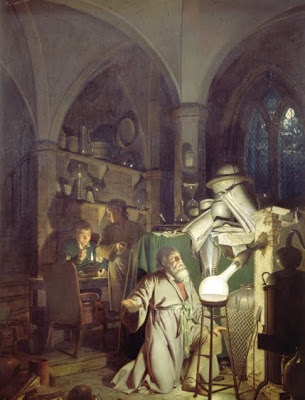Philosophy
 Joseph Wright
Joseph Wright
September 3rd, 1734 to August 29th, 1797
 A Philosopher giving that Lecture on the Orrery, in which a lamp is put in place of the Sun
A Philosopher giving that Lecture on the Orrery, in which a lamp is put in place of the Sun
Joseph Wright's masterpiece depicts a ‘Natural Philosopher’ - or scientist, using an Orrery to demonstrate the workings of the solar system. A light has been placed in the position of the sun, probably to demonstrate the causes of eclipses. The rays from this flood over the group and act as a painted metaphor for the light of knowledge that the group receives, and indeed for the ‘age of enlightenment’ itself.
An Orrery is an early form of planetarium. Travelling lectures were organized up and down the country to explain the latest scientific developments and it is likely that Wright attended one in Derby. The Orrery was invented in the early eighteenth century to show the movement of the planets round the sun during the course of the year. It was named after the Earl of Orrery who was the patron of the invention.
The audience listening to the philosopher consists of ordinary, middle-class people and their faces express surprise and wonderment at what they are hearing. It is important to remember that it was still relatively recently that Newton had claimed that the planets moved around the sun - and not around the earth. It is fitting, therefore, that Wright has modelled his philosopher on a painting of Isaac Newton by Godfrey Kneller. The figure to the left of the philosopher is Wright's friend Peter Perez Burdett. None of the other figures have been identified but they represent a good variety of types that add interest to the composition.
Along with Experiment on a Bird in the Air Pump this is probably one of Wright's most famous paintings. It is certainly one of the most popular with visitors to Derby. The painting was purchased by public subscription in 1884 and presented to Derby Art Gallery. In 1973 the painting and frame were restored and it has since remained a centre piece of the Museum's collection.
And...
 The Alchymist Discovering Phosphorus
The Alchymist Discovering Phosphorus
Before modern science developed, alchemists combined knowledge, magic and religion in a search for the philosopher's stone that could turn ordinary metal into gold. This particular alchemist begins hoping to produce the elusive philosophers stone and ends, to his amazement, in discovering phosphorus. Phosphorus had been discovered just under a 100 years before the picture was painted.
There are obvious religious connotations to the painting; the setting, for example, resembles church architecture with its pointed windows and gothic arches. Wright has also incorporated imagery taken from the repertoire of religious art into the figure of the alchemist. The alchemist kneels with outreached hands in a similar pose to that used to St Francis receiving the stigmata or St Jerome in prayer.
Wright often used this technique of dramatic light effects created by an internal light source that reveals a tremendous amount of detail in the surroundings.
The placing of the two boys is another popular device, like that seen in the Blacksmiths Shop, which Wright uses to add interest to the composition and which draws us into the detail of the dark background.
Currently in the Joseph Wright Gallery at Derby Museum and Art Gallery.
Bill Ashworth [University of Missouri at Kansas City professor] wrote...
Joseph Wright, a British painter, was born Sep. 3, 1734. Wright became the unofficial artist of the scientific and industrial revolutions, because of his choice of subjects. His three most famous paintings depict the discovery of phosphorus, an experiment with an air pump, and the wonders of the orrery (a predecessor of the planetarium). The paintings are unusual because of the way they are lit; in the depiction of the discovery of phosphorus, most of the light in the painting radiates from the glowing element in the flask; similarly, in the depiction of the orrery, the light is provided by the central sun in the planetarium. Wright's status as painter of the sciences was reinforced by his membership in the Lunar Society, which consisted of scientists living around Birmingham, and included Erasmus Darwin, Matthew Boulton, Josiah Wedgwood, and James Watt. Wright painted portraits of most of these as well. “The Alchemist” [the mischosen name often used for the “Discovery of Phosphorus”] and “The Orrery” are both at the Art Museum in Wright's home town of Derby, England.
Joseph Wright [Wikipedia]
- The Feast Of Saint Steven
My Fellow Comedists, This weekend we celebrate the feast of Saint Steven. Steven Wright, the Salvador Dali of observational comedy, turns 54 this weekend. A Boston-area native, he did it the honest way, working ope-mics at Ding Ho, a half-Chinese restaurant/half...
- God, Darwin, And Conservative Kumbaya
In a recent op/ed in The New York Times, Robert Wright offers a "grand bargain" in a bid to arrange a ceasefire in the war between the religious and those who accept evolution. We can form, he argues, a theory completely consistent with evolution by simply...
- Drug-resistant Bacteria...pathway To Man's Demise?
The Lachuguilla cave system, where scientists discovered antibiotic-resistant bacteria, is part of Carlsbad Caverns National Park in New Mexico. Above, an explorer admires the the Selenite Chandelier display in Carlsbad Caverns."Drug-Resistant Bacteria...
- Orrery Planetarium
Specialized...transit of Venus. The phrase 'transit of Venus' refers to the passage of the planet Venus across the face of the sun, as seen from Earth. Such transits occur in pairs eight years apart, with an interval of over 100 years between...
- James Ferguson...significant Scottish Astronomer
James Ferguson April 25th, 1710 to November 17th, 1776 Astronomy Explained Upon Sir Isaac Newton's Principles and Made Easy to Those Who Have Not Studied Mathematics This is a detail from a large folding plate in James Ferguson's Astronomy...
Philosophy
Joseph Wright...art and science
 Joseph Wright
Joseph WrightSeptember 3rd, 1734 to August 29th, 1797
 A Philosopher giving that Lecture on the Orrery, in which a lamp is put in place of the Sun
A Philosopher giving that Lecture on the Orrery, in which a lamp is put in place of the Sun Joseph Wright's masterpiece depicts a ‘Natural Philosopher’ - or scientist, using an Orrery to demonstrate the workings of the solar system. A light has been placed in the position of the sun, probably to demonstrate the causes of eclipses. The rays from this flood over the group and act as a painted metaphor for the light of knowledge that the group receives, and indeed for the ‘age of enlightenment’ itself.
An Orrery is an early form of planetarium. Travelling lectures were organized up and down the country to explain the latest scientific developments and it is likely that Wright attended one in Derby. The Orrery was invented in the early eighteenth century to show the movement of the planets round the sun during the course of the year. It was named after the Earl of Orrery who was the patron of the invention.
The audience listening to the philosopher consists of ordinary, middle-class people and their faces express surprise and wonderment at what they are hearing. It is important to remember that it was still relatively recently that Newton had claimed that the planets moved around the sun - and not around the earth. It is fitting, therefore, that Wright has modelled his philosopher on a painting of Isaac Newton by Godfrey Kneller. The figure to the left of the philosopher is Wright's friend Peter Perez Burdett. None of the other figures have been identified but they represent a good variety of types that add interest to the composition.
Along with Experiment on a Bird in the Air Pump this is probably one of Wright's most famous paintings. It is certainly one of the most popular with visitors to Derby. The painting was purchased by public subscription in 1884 and presented to Derby Art Gallery. In 1973 the painting and frame were restored and it has since remained a centre piece of the Museum's collection.
And...
 The Alchymist Discovering Phosphorus
The Alchymist Discovering PhosphorusBefore modern science developed, alchemists combined knowledge, magic and religion in a search for the philosopher's stone that could turn ordinary metal into gold. This particular alchemist begins hoping to produce the elusive philosophers stone and ends, to his amazement, in discovering phosphorus. Phosphorus had been discovered just under a 100 years before the picture was painted.
There are obvious religious connotations to the painting; the setting, for example, resembles church architecture with its pointed windows and gothic arches. Wright has also incorporated imagery taken from the repertoire of religious art into the figure of the alchemist. The alchemist kneels with outreached hands in a similar pose to that used to St Francis receiving the stigmata or St Jerome in prayer.
Wright often used this technique of dramatic light effects created by an internal light source that reveals a tremendous amount of detail in the surroundings.
The placing of the two boys is another popular device, like that seen in the Blacksmiths Shop, which Wright uses to add interest to the composition and which draws us into the detail of the dark background.
Currently in the Joseph Wright Gallery at Derby Museum and Art Gallery.
Bill Ashworth [University of Missouri at Kansas City professor] wrote...
Joseph Wright, a British painter, was born Sep. 3, 1734. Wright became the unofficial artist of the scientific and industrial revolutions, because of his choice of subjects. His three most famous paintings depict the discovery of phosphorus, an experiment with an air pump, and the wonders of the orrery (a predecessor of the planetarium). The paintings are unusual because of the way they are lit; in the depiction of the discovery of phosphorus, most of the light in the painting radiates from the glowing element in the flask; similarly, in the depiction of the orrery, the light is provided by the central sun in the planetarium. Wright's status as painter of the sciences was reinforced by his membership in the Lunar Society, which consisted of scientists living around Birmingham, and included Erasmus Darwin, Matthew Boulton, Josiah Wedgwood, and James Watt. Wright painted portraits of most of these as well. “The Alchemist” [the mischosen name often used for the “Discovery of Phosphorus”] and “The Orrery” are both at the Art Museum in Wright's home town of Derby, England.
Joseph Wright [Wikipedia]
- The Feast Of Saint Steven
My Fellow Comedists, This weekend we celebrate the feast of Saint Steven. Steven Wright, the Salvador Dali of observational comedy, turns 54 this weekend. A Boston-area native, he did it the honest way, working ope-mics at Ding Ho, a half-Chinese restaurant/half...
- God, Darwin, And Conservative Kumbaya
In a recent op/ed in The New York Times, Robert Wright offers a "grand bargain" in a bid to arrange a ceasefire in the war between the religious and those who accept evolution. We can form, he argues, a theory completely consistent with evolution by simply...
- Drug-resistant Bacteria...pathway To Man's Demise?
The Lachuguilla cave system, where scientists discovered antibiotic-resistant bacteria, is part of Carlsbad Caverns National Park in New Mexico. Above, an explorer admires the the Selenite Chandelier display in Carlsbad Caverns."Drug-Resistant Bacteria...
- Orrery Planetarium
Specialized...transit of Venus. The phrase 'transit of Venus' refers to the passage of the planet Venus across the face of the sun, as seen from Earth. Such transits occur in pairs eight years apart, with an interval of over 100 years between...
- James Ferguson...significant Scottish Astronomer
James Ferguson April 25th, 1710 to November 17th, 1776 Astronomy Explained Upon Sir Isaac Newton's Principles and Made Easy to Those Who Have Not Studied Mathematics This is a detail from a large folding plate in James Ferguson's Astronomy...
